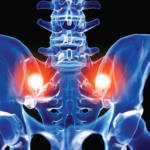Disease burden seems comparable between axSpA and axPsA.5 Dr. Molto concluded, “In my opinion, the take-home message is that there are some phenotypical differences between the two, particularly in imaging at the cervical spine, but the burden of disease is comparable. It is very important that we do not forget to check the spine in our PsA patients.”
Some phenotypical differences between axial spondyloarthropathy (axSpA) and axial involvement in psoriatic arthritis (axPsA) exist, particularly in imaging at the cervical spine, but the burden of disease is comparable, according to Anna Molto, MD, PhD.
Treatment
Atul Deodhar, MD, MRCP, professor of medicine, Division of Arthritis and Rheumatic Diseases, Oregon Health & Science University, Portland, Ore., closed out the session with insights into the treatment of axSpA and axPsA.
“In 2021, we are fortunate to have data to support the efficacy of several different therapeutic options—biologics, as well as Janus kinase inhibitors—for axSpA and non-radiographic axSpA,” said Dr. Deodhar. “Overall, response rates seem to be similar among classes, although head-to-head trials are yet to be conducted.”
However, Dr. Deodhar drew attention to the fact that interleukin (IL) 12/23 inhibition has not proved helpful in ankylosing spondylitis, with both ustekinumab and risankizumab failing to show benefits.6,7
“Why might this be?” he asked. “Cells that secrete IL-23 are more common in the peripheral skeleton than the axial skeleton, which may explain these discrepancies. IL-23 may also not be that important in the pathogenesis of osteitis, the predominant lesion in axSpA. Also, there are IL-23 independent cells that secrete IL-17, a dominant pro-inflammatory cytokine important in axSpA pathology.8 So IL-23 inhibition doesn’t work well in axSpA, but would it work in axPsA?”
Recent trials examining the efficacy of ustekinumab and guselkumab have shown benefit in axPsA.9,10 IL-17 inhibition with secukinumab and ixekizumab has also shown promise.11,12 “Our new direction is confirming whether drugs that work for axSpA work for axPsA patients too. [Because] these two entities are not identical, drugs that work well for one may not work well for the other and vice versa,” Dr. Deodhar said.
Dr. Deodhar was careful to highlight weaknesses of axPsA studies, thus far. “First, there is often no specific information about how the diagnosis of axPsA was made and no classification criteria were used [because] none exist. Some studies lack imaging requirements of any kind, and others have heterogeneous imaging findings. Lastly, the Bath Ankylosing Spondylitis Disease Activity Index (BASDAI) and Ankylosing Spondylitis Disease Activity Score (ASDAS) are outcome measures created specifically for ankylosing spondylitis and not axPsA,” he noted.



